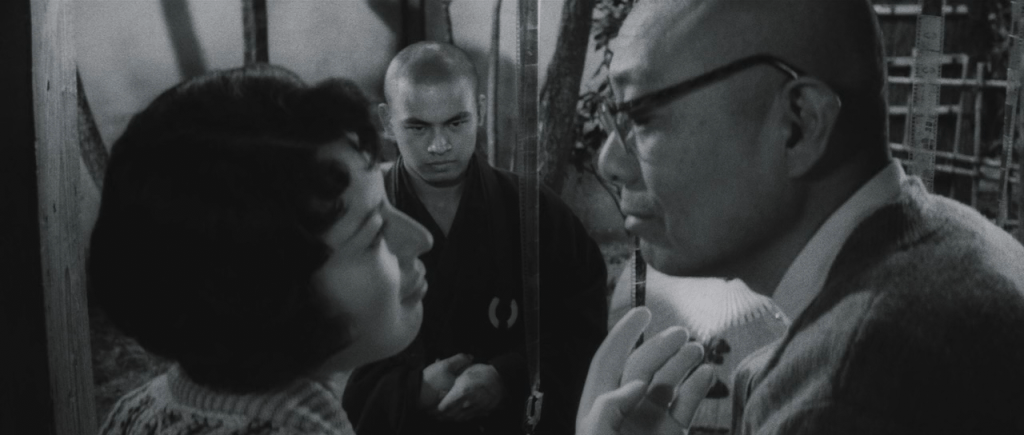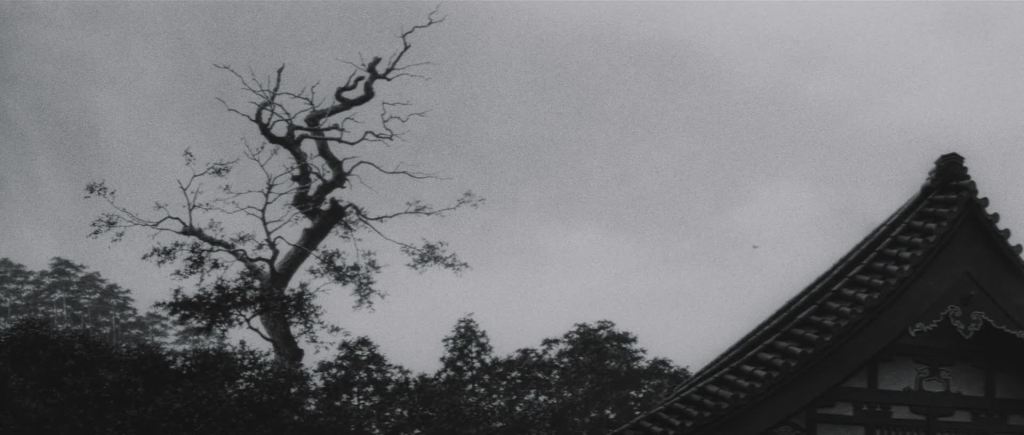Introduction
When Tsutomi Mizukami published his semi-biographical Gan no tera (Temple of the Geese) (1961), a novel semi-fictionalizing his own trajectory of disillusionment within a Zen Buddhist temple, his novel did not only win the prestigious Naoki Prize, but also quickly found his way to the silver screen. Already in 1962, Yuzo Kawashima presented his ‘reading’ or his ‘interpretation’ of Mizukami’s popular novel.
Review
On his deathbed, Nangaku Kishimoto (Ganjiro Nakamura), a famous painter with a weakness for women, asks Jikai (Masao Mishima), a Zen Buddhist abbot who says he has renounced love, late, and god, to take care of his mistress Satoko Kirahara (Ayako Wakao).
On the seventh day after Nangaku’s funeral, Satoko finally visits the abbot’s temple. Overjoyed with her visit, he invites her to drink together with him. Later that night, after reprimanding his new monk Jinen Horinouchi (Kunikazu Takami), he tells Satoko about Nangaku’s wish and, drunk on sake and burning with passion, throws himself on her. While Satoko, at first, resists, she ultimately accepts his advances.
The temple of the Wild Geese is a beautiful Freudian oedipal drama – a drama exploring how an acting-out reveals the ‘infantile’ unconscious desire at play within the logic of the subject. While the oedipal dimension is not apparent from the get-go, the unfolding of the narrative leaves no doubt that everything that transpires in the narrative is driven by an unassumed and unrecognized oedipal desire.
As exploring the oedipal theme would reveal the point of the narrative (see Narra-note 3 for a deeper commentary), we will contend ourselves to elucidate the problematic position of Jikai, the abbot, and the problematic presence of Satoko for Jinen.
The position of Jikai as abbot is problematic due to his erotic indulgence in Satoko. This indulgence does not only make him neglect his duties as abbot (e.g. skipping temple meetings, … etc.) but also reveals how empty his vows to follow the teachings of Zen Buddhism are. This revelation problematizes the whole dynamic between him and Jinen, his student, as his indulgence in pleasure robs him of his position of authority. As Jikai has, in Jinen’s eyes, no authority, the dynamic between them is reduced to a dynamic of abuse.
In other words, Jikai has no authority, as his erotic indulgence in Satoko and his inability to hide his phallic desire for pleasure reveals him as being nothing but a fraud. The true drama for Jinen is thus not that the master exploits him, but that the exploiting master is a fraud and that his words are as much truth, as they follow the Zen Buddhist tradition, as they are lies, because the same words reveal that the master who professes the word fails to abide by his own teachings.
The ‘fraudulous’ abbot is, nevertheless, not the only element that disturbs Jinen. The other disturbing element, as one rightly expects, is the ‘seductive’ female element, Satoko. Jinen, who desires to pursue the truth of Zen Buddhism righteously, is due to Satoko’s presence continuously in danger of being confronted with his own earthly sexual desires. To repress his pulsating sexual desire, Jinen attempts to evade any situation where her female body can fall under his male gaze, but he fails because his scopic drive, the drive that gives Satoko’s female body the power to enflame his sexual desire, demands satisfaction (Narra-note 1). Jinen’s glimpsing of the Satoko’s female shape is thus not accidental but driven by a sexual desire that does not want (or cannot) to be silenced, a desire that he does not want to assume yet. What will happen if Jinen acts upon this desire (Narra-note 2, Narra-note 3 (spoiler))?
The slow-flowing composition of The Temple Of The Wild Geese – a mixture of static shots and, in very rare instances, a dynamic shot – is noteworthy for two different elements: the artful geometrical shot-compositions and the thoughtful way tension is generated within the composition.
The way Kawashima utilizes geometry to compose his shots is downright extraordinary. The thoughtfully exploitation of the geometry of the temple interiors allows Kawashima to create shots that are not only visually and narratively interesting but also highly pleasing at an aesthetical level.
In The Temple Of The Wild Geese tension is generated via three elements. The first element is musical accompaniment, which is subtly used to heighten, little by little as the narrative unfolds, the tension. The second element important in heightening the relational tension is the subtle modulation of light and shadows. And the final element concerns the thoughtful use of more dramatic camera-perspectives.
The Temple Of The Wild Geese is a wonderful Freudian oedipal drama, not only because the narrative explores with great subtlety how some acts in the present are, unbeknownst to the subject, dictated by an unconscious ‘infantile’ oedipal desire, but also because Kawashima stages this Freudian exploration of unconscious desires with an extraordinary compositional artistry. We duly recommend this narrative.
[No Trailer available]
Notes
Narra-note 1: It is important to underline that Jinen does not only attempt to evade Satoko at the level of his gaze, but also tries to avoid her at the level of his speech. In other words, he does not want to see her, and he also does not want to speak to her.
Narra-note 2: Jinen wants to keep his real name Sute(kichi) and his past hidden from the abbot and his wife. In our view, Jinen’s wish to hide his past is not only a wish to hide the fact that he was abandoned by his mother but also the fact that he occupied/occupies the position of filth.
Jinen aims to purify himself and escape the position of filth by following the pure way of Zen Buddhism, but his attempt of purification and escape this problematic subjective (and social) position is problematized by the encounter with his own dirty sexual desires as well as with the vile ways of his master. Central to both his own sexual desires and the impure ways of his master is, to no one’s surprise, a female body.
Narra-note 3: One should read Jinen’s act of accepting his sexual desire as an assumption of the impure position he tried to escape within Zen Buddhism. It is this act of assuming his sexual desires – desires as being, per definition, impure – that allows him to do the (violent) things he eventually does – the image as monk, just like for his master and abbot, becomes nothing but a facade.
His violent act is, at the level of the unconscious, a radical oedipal act – an act that, if one reads between the lines, is all about the mother and the father. Jinen desires Satoko in her semblance of a mother and hates Jikai in his semblance of a father. Jinen’s act in the ‘real’ thus reveals that the prime conflict that troubles him is oedipal.
The unconscious oedipal conflict that marks Jinen’s subject, a conflict that forces its expression in Jinen’s pulsating sexual desire and in his violent act, is just like his restless sexual desire and his desire to know his parents non-illusionary. This conflict, acted-out but not consciously assumed, guides the subject beyond his own conscious will. In this sense, one can say that Jinen’s conscious desire to know his parents is, unbeknownst to himself, already perverted by his unconscious oedipal desire, i.e. the desire to possess the mother. This is later confirmed by what happens with the image of the mother goose in the temple.
Cine-note 1: At one point in the narrative, when Jikai, the abbot, is talking to the abbot of Genko Temple, one can find what seems like some continuity errors. Yet, these are not continuity errors, but slightly confusing cinematographical situations created by, what is in our opinion, an unthoughtful application of the cut.





